None
Most users ever online was 387 on Tue Dec 05, 2023 7:35 pm
The newest registered user is Skylines3
Our users have posted a total of 47502 messages in 4941 subjects
| No user |
• The FREE hand reading services at the Modern Hand Reading Forum are being continued in 2019 with the assistance of Google adsense!

Learn how to read hands according the Modern Hand Reading paradigm & you can use this forum as your palm reading guide!
Any Body Can Give Any Answer For This (length life line)
Modern Hand Reading Forum - Discover the language of your hands: palm reading & palmistry forum! :: III - MODERN HAND READING - Various systems for reading hands! :: IIIa - Modern Palmistry: general topics, questions
Page 7 of 10 •  1, 2, 3, 4, 5, 6, 7, 8, 9, 10
1, 2, 3, 4, 5, 6, 7, 8, 9, 10 
 Re: Any Body Can Give Any Answer For This (length life line)
Re: Any Body Can Give Any Answer For This (length life line)
Apologies if I am being slow to understand. Yes I know the lines are permanent. Am I correct in saying that the boundary between the hypothenar and thenar is the lifeline? In a case like Martijn's aunt, how does this help us to decide if the lower line is a lifeline or fate line? We don't know if it formed in a groove. ??Patti wrote:Once the main lines form in the fetus, they are permanent. The boundary between the hypothenar and the thenar is permanent.
 Re: Any Body Can Give Any Answer For This (length life line)
Re: Any Body Can Give Any Answer For This (length life line)
Lynn wrote:Apologies if I am being slow to understand. Yes I know the lines are permanent. Am I correct in saying that the boundary between the hypothenar and thenar is the lifeline? In a case like Martijn's aunt, how does this help us to decide if the lower line is a lifeline or fate line? We don't know if it formed in a groove. ??Patti wrote:Once the main lines form in the fetus, they are permanent. The boundary between the hypothenar and the thenar is permanent.
Or I'm too

The thenar crease is described as forming in the groove and the groove is being defined as the dividing factor between the thenar and hyperthenar pads/eminences.
If surgeons were looking at a hand with a single longitudinal crease and it flowed upward without turning toward the radial side, as well as located in this groove, it would be the thenar crease. The proximal section of the thenar crease.
Medical texts describe the thenar as starting/ending above the wrist at the center. The creases that branch around the thumb or in the other direction are likely branches and could be labeled in various ways. I think we have always agreed the ends/beginnings of the major creases as being more prone to change i.e. grow, strengthen or weaken and shorten, etc., whereas the central portion more permanent.
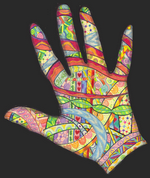
Patti- Posts : 3912
Join date : 2010-07-24
 Re: Any Body Can Give Any Answer For This (length life line)
Re: Any Body Can Give Any Answer For This (length life line)
Patti wrote:If surgeons were looking at a hand with a single longitudinal crease and it flowed upward without turning toward the radial side, as well as located in this groove, it would be the thenar crease. The proximal section of the thenar crease.
But how would they know if it was formed in a groove? The grooves disappear at the same time as the volar pads regress, around 12 weeks.
 Re: Any Body Can Give Any Answer For This (length life line)
Re: Any Body Can Give Any Answer For This (length life line)
Lynn wrote:Apologies if I am being slow to understand. Yes I know the lines are permanent.Patti wrote:Once the main lines form in the fetus, they are permanent. The boundary between the hypothenar and the thenar is permanent.
I wish to amend what I said there! The lines are not permanent as in unchanging - we know the lines can change.
 Re: Any Body Can Give Any Answer For This (length life line)
Re: Any Body Can Give Any Answer For This (length life line)
Lynn wrote:Patti wrote:If surgeons were looking at a hand with a single longitudinal crease and it flowed upward without turning toward the radial side, as well as located in this groove, it would be the thenar crease. The proximal section of the thenar crease.
But how would they know if it was formed in a groove? The grooves disappear at the same time as the volar pads regress, around 12 weeks.
The major creases are anchored into several layers of skin so that the skin doesn't slide across the palm. Where they are attached at this deeper level, they don't move around or relocate. The thenar crease initially forms in the space between the thenar and the hypothenar eminences, and in the area where the interdigital pad between thumb and index is located. and stays in that location.
Also, the thenar area and the hypothenar area have different sets of muscles. The thenar crease is in the boundary zone between these muscle groups.
The ends of the major creases or more likely to change than the central portion. I didn't think there was disagreement here..?

Patti- Posts : 3912
Join date : 2010-07-24
 Re: Any Body Can Give Any Answer For This (length life line)
Re: Any Body Can Give Any Answer For This (length life line)
Martijn (admin) wrote:
Patti, I now recognize that where I mentioned the dissociated head line this kind of became a confusing element regarding the point I was trying to make.
So, I apologize for this confusing element (which might have made it look like as if my request included a contradiction).
Therefore I will now make a new attempt to deliver my 'proof' with the following guideline:
A life line will never enter the 'upper palmar zone' at the ulnar side of the triradius below the index finger.
(This guideline is resulting from the fact that a normal life line always progresses downward from from the radial termination point at the 2nd interdigital zone to the center zone at the wrist!)
A fundamental guideline... which could help us to finish this discussion!
I could also translate this fundamental guideline into:
Any normal life line will not pass the 'virtual horizontal plain A-B' (see picture below) at the ulnar side of the a-tradius below the index finger.
NOTICE: The 'virtual horizontal plain A-B' is found between the start of radial termination point of the life line (point A) and the ulnar termination point of the heart line (B)
We can see in the picture that the fate line in my aunt's hand does reach out to the virtual line A-B at a point below the middle finger (at a point only about 1 cm at the radial side of the triradius under de 3rd finger).
And this is actually a very typical characteristics for any fate line that is long enough to pass the head line!
Sorry Patti, for this reason I observe that the fate line in my aunt's hand can VERY LIKELY not be said to show the typical 'placement' (quoted from your words) for a life line: because it violates the sensible guideline that I presented above!
Patti, in my view you can simply 'proof' that my new statement regarding the virtual horizontal plain A-B is not correct by finding a hand print example without a 'short life line variant' that shows the same characteristic for the life line.
Will you now accept my challenge?
(Or maybe you are now willing to acknowledge/confirm that the 4th part of the line in my aunt's hand does show a characteristic that is rather unsually for life line!?)
Because of the nature of the thenar crease to form in at least two sections, there will almost always be a place where the longitudinal section meets the section that starts radially. Sometimes this crease, when it continues upward can be seen as an ambition line at around the age of 18.
The life line isn't normally located above the A-B plane. Ends of creases (from broken and/or overlapping lines) may extend in a fading fashion upwards across the head line due to hand use and structure.
The 'a' triradius can also be found located near the radial edge of the palm or closer to the middle finger, how would this change your plane?
Basically, again you are mostly safe in your chosen guidelines for the area by the fingers because it's a rare location to find the life line, and by adding 'normal' makes your guidelines even safer.
Since no one is really looking for a life line up by the fingers - what purpose does this serve?

Patti- Posts : 3912
Join date : 2010-07-24
 Re: Any Body Can Give Any Answer For This (length life line)
Re: Any Body Can Give Any Answer For This (length life line)
Patti wrote:Lynn wrote:Apologies if I am being slow to understand. Yes I know the lines are permanent. Am I correct in saying that the boundary between the hypothenar and thenar is the lifeline? In a case like Martijn's aunt, how does this help us to decide if the lower line is a lifeline or fate line? We don't know if it formed in a groove. ??Patti wrote:Once the main lines form in the fetus, they are permanent. The boundary between the hypothenar and the thenar is permanent.
Or I'm too
The thenar crease is described as forming in the groove and the groove is being defined as the dividing factor between the thenar and hyperthenar pads/eminences.
If surgeons were looking at a hand with a single longitudinal crease and it flowed upward without turning toward the radial side, as well as located in this groove, it would be the thenar crease. The proximal section of the thenar crease.
Medical texts describe the thenar as starting/ending above the wrist at the center. The creases that branch around the thumb or in the other direction are likely branches and could be labeled in various ways. I think we have always agreed the ends/beginnings of the major creases as being more prone to change i.e. grow, strengthen or weaken and shorten, etc., whereas the central portion more permanent.
Patti, maybe you are far too much
 ... and loosing track with 'the obvious', because when we take a look at the life line example in most books about hand reading then we see usually a life line that is ending at the RADIAL side of the palm!
... and loosing track with 'the obvious', because when we take a look at the life line example in most books about hand reading then we see usually a life line that is ending at the RADIAL side of the palm!Now, I think you have so far in this topic presented only a few examples of scientific sources which describe a general description for the path of the normal path of the thenar crease.
(I noticed that Lynn also started asking questions about where you actually found your assumptions/conclusions regarding what your quotes describe - and I likewise wonder about the origins of your statement regarding what 'surgeons' would describe)
Because when we dive into sources which present more detailed info about where the thenar tends to develop exactly... a very different picture rises compared to your assumptions regarding the rather general descriptions in the scientific works that you presented earlier (such as your incorrect assumption above - labeled with red color).
This example describes why your assumption is incorrect:
Because due to the bone structure the thenar crease actually tends to follow a path ending at the upper radial side of the wrist due to the underlying bone structure, see the picture below.
Source:
'Hand and Wrist' (page 2) - http://books.google.nl/books?hl=en&lr=&id=vIgv982Vkt0C&
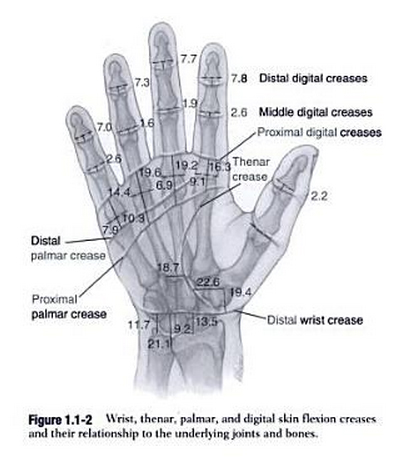
PS. You have been talking a few times about as if the life line develops as if there are two creases involved, but in the article 'Embryologic Development of Flexion Crease' we can read that the thenar crease starts developing in week 8 of gestation on the radial side between thumb and index fingers, and in week 10 the thenar crease extends to the center of the palm along the thenar pad.
And it's hard for me to understand why you started talking about the 'ambition line', because that definitely is a matter that relates to the topic 'minor creases'.
By the way, your suggestion that it is rare for the thenar crease to cross the distal ridge-line rising from the t-traradius... is also not correct because in my studies I have notice that in many hands (maybe even above 10%) that ridge-line actually ends in the upper thenar just below the radial termination point of the life line.
 Re: Any Body Can Give Any Answer For This (length life line)
Re: Any Body Can Give Any Answer For This (length life line)

Kimura mentions both directions. You have to read a little further and not just select a statement that fits your purposes. I shared both quotes and the locations I found them.
I've studied the various sketches at many websites and from books I have, and personally I think the sketch adds more support to the outer location for the life line to be located that I have described in these split and overlapping lines. Not only the short extended line of Mars. Note the location where the thenar crease is covering the middle finger metacarpal bone! This is the most common location for the life line (thenar crease) and fate line (middle finger crease) to combine into one line. You might want to look at the veins, too.
Sorry, but after tonight I need to focus my attention on several upcoming projects and events. I'll keep an eye on the thread to see how it develops.



Patti- Posts : 3912
Join date : 2010-07-24
 Re: Any Body Can Give Any Answer For This (length life line)
Re: Any Body Can Give Any Answer For This (length life line)
Patti wrote:Martijn (admin) wrote:
Patti, I now recognize that where I mentioned the dissociated head line this kind of became a confusing element regarding the point I was trying to make.
So, I apologize for this confusing element (which might have made it look like as if my request included a contradiction).
Therefore I will now make a new attempt to deliver my 'proof' with the following guideline:
A life line will never enter the 'upper palmar zone' at the ulnar side of the triradius below the index finger.
(This guideline is resulting from the fact that a normal life line always progresses downward from from the radial termination point at the 2nd interdigital zone to the center zone at the wrist!)
A fundamental guideline... which could help us to finish this discussion!
I could also translate this fundamental guideline into:
Any normal life line will not pass the 'virtual horizontal plain A-B' (see picture below) at the ulnar side of the a-tradius below the index finger.
NOTICE: The 'virtual horizontal plain A-B' is found between the start of radial termination point of the life line (point A) and the ulnar termination point of the heart line (B)
We can see in the picture that the fate line in my aunt's hand does reach out to the virtual line A-B at a point below the middle finger (at a point only about 1 cm at the radial side of the triradius under de 3rd finger).
And this is actually a very typical characteristics for any fate line that is long enough to pass the head line!
Sorry Patti, for this reason I observe that the fate line in my aunt's hand can VERY LIKELY not be said to show the typical 'placement' (quoted from your words) for a life line: because it violates the sensible guideline that I presented above!
Patti, in my view you can simply 'proof' that my new statement regarding the virtual horizontal plain A-B is not correct by finding a hand print example without a 'short life line variant' that shows the same characteristic for the life line.
Will you now accept my challenge?
(Or maybe you are now willing to acknowledge/confirm that the 4th part of the line in my aunt's hand does show a characteristic that is rather unsually for life line!?)
Because of the nature of the thenar crease to form in at least two sections, there will almost always be a place where the longitudinal section meets the section that starts radially. Sometimes this crease, when it continues upward can be seen as an ambition line at around the age of 18.
The life line isn't normally located above the A-B plane. Ends of creases (from broken and/or overlapping lines) may extend in a fading fashion upwards across the head line due to hand use and structure.
The 'a' triradius can also be found located near the radial edge of the palm or closer to the middle finger, how would this change your plane?
Basically, again you are mostly safe in your chosen guidelines for the area by the fingers because it's a rare location to find the life line, and by adding 'normal' makes your guidelines even safer.
Since no one is really looking for a life line up by the fingers - what purpose does this serve?
Patti, in my former post I addressed the issues regarding your 1st and 3rd statements.
Well... I am happy to see that at last you now have acknowledged that "the life line isn't normally located above the A-B plane"!
Remember, earlier in this topic you have claimed that the upper part of the fate line in my aunt's hand should be judged by 'formation' - and I think you described it to be only normal and challenged me to 'proof' my point of view.
NOTICE: Since in your view that line also enters/fuses with the head line... this sort of implicates that in your perceptions the life line is described to come above the A-B plane (I must add here that in my posts I have described that I observe that it actually stops just below the head line).
Regarding your comment about the a-triradius... those variations hardly have any implications (you would have found this yourself as well if you had taken up my challenge).
Finally, regarding your last 2 comments... apparently you don't remember that earlier in this discussion there was a person who has found a life line that is rising above A-B plain and not far away from the fingers:
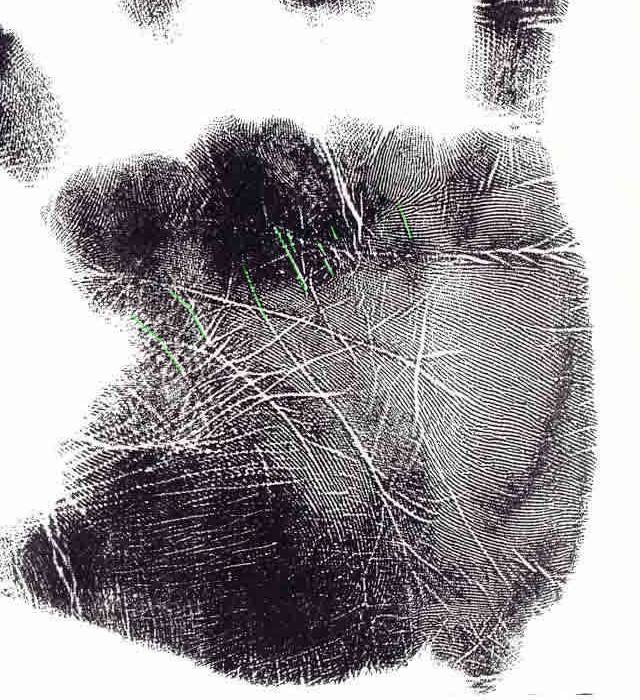
 Re: Any Body Can Give Any Answer For This (length life line)
Re: Any Body Can Give Any Answer For This (length life line)
You probably haven't read the associated post either.
But anyway, the green markings represent group of creases that show flexing together when the hand bunches in some repeated motion.
There is a second image colored differently. I explained myself fairly in detail in the comment.
This is another example of my comments being superficially read and then misrepresented by you. Arrrrgh!!!!
Good night!

Patti- Posts : 3912
Join date : 2010-07-24
 Re: Any Body Can Give Any Answer For This (length life line)
Re: Any Body Can Give Any Answer For This (length life line)
Martijn (admin) wrote:
Finally, regarding your last 2 comments... apparently you don't remember that earlier in this discussion there was a person who has found a life line that is rising above A-B plain and not far away from the fingers
WAIT!!! Are you acknowledging the longitudinal crease that rises above the A-B plane as the life line? I mean, like, in agreement with me?? I almost missed that!!


Patti- Posts : 3912
Join date : 2010-07-24
 Re: Any Body Can Give Any Answer For This (length life line)
Re: Any Body Can Give Any Answer For This (length life line)
Patti wrote:
Kimura mentions both directions. You have to read a little further and not just select a statement that fits your purposes. I shared both quotes and the locations I found them.
Patti, I have noticed that earlier in this topic you refered twice to Kimura.
And I noticed that Lynn already asked a few questions regarding how you have used Kimura's work as a support for your position:
https://www.modernhandreadingforum.com/t166p135-any-body-can-give-any-answer-for-this-length-life-line#22471
(You have also refered to Kimura in this post:
https://www.modernhandreadingforum.com/t166p105-any-body-can-give-any-answer-for-this-length-life-line#22448 )
Sorry Patti, but I don't think that these quotes from Kimura's work show much support for your ideas about 2 or more lines being involved in the development of the thenar crease... nor do they support your view that any line in the carpal mid-axis of the palm should be associated with a life line.
Because since the path of the fate line for a considerable part relates to the location of the 3rd metacarpal bone and the underlying wrist bones (though the location of the life line, head line and the dermatoglyphics also play a role in it's formation), it becomes obvious why a single vertical line in the carpal palmar zone can also represent a long fate line that travels all the way up through the palm beyond the A-B plane and the head lines - as seen in the picture in my former post
(I present the picture below once again, because it shows the 3rd metacarpal bone and the wrist bones that I have just mentioned)

 Re: Any Body Can Give Any Answer For This (length life line)
Re: Any Body Can Give Any Answer For This (length life line)
Patti wrote:Martijn (admin) wrote:
Finally, regarding your last 2 comments... apparently you don't remember that earlier in this discussion there was a person who has found a life line that is rising above A-B plain and not far away from the fingers
WAIT!!! Are you acknowledging the longitudinal crease that rises above the A-B plane as the life line? I mean, like, in agreement with me?? I almost missed that!!

 No Patti... you are that 'person'!
No Patti... you are that 'person'!(Maybe you had forgotten that just like Lynn I have described that example to have a 'short life line' and a 'n 'normal fate line')
 Re: Any Body Can Give Any Answer For This (length life line)
Re: Any Body Can Give Any Answer For This (length life line)
Martijn (admin) wrote:Patti wrote:
The life line frequently pulls inward toward the thumb and back outward away from the thumb throughout its course. It also breaks and branches... as does your aunt's crease.
The description fits either a fate line or a life line.
Patti, sounds like you are suggesting that all characteristics seen in my aunt's fate line are only natural for a life line to have.
And implicit you are kind of denying here that it is actually much more normal for a fate line to have so many 'outward curving' characteristics - than for a life line.
Apparently somehow you prefer not to post any detailed description for my aunt's hand; which I recognize as a huge handicap to find any agreement at all between our view... because it was actually this example that made us start this discussion.Patti, would you mind to comment with on this new example of a 'short life line' that I presented earlier today - how would your prefer to describe it: just a short life line... or would you prefer to describe the central vertical line also as a life line?
(EDIT: Sorry Patti, I hadn't noticed that you already posted a few thoughts in an earlier comment)
Maybe this is helpful.


Patti- Posts : 3912
Join date : 2010-07-24
 Re: Any Body Can Give Any Answer For This (length life line)
Re: Any Body Can Give Any Answer For This (length life line)
Martijn (admin) wrote:Patti wrote:Martijn (admin) wrote:
Lynn, I hope you have noticed that I have pointed out by detail that the fate line in my aunt's hand qualifies for all typical characteristic of a fate line (for each of the 3 parts of that line!).
The characteristics of a fate line range greatly. It's easy to fit the description of a fate line.
Well yes Patti, the characteristics of a fate line vary. But I would say that it is pretty obvious that a true life line can not fit the description of a fate line... because otherwise the definitions for lines would present some 'overlap'; and I think this is never gets mentioned in the definitions for those lines.
(Of course, I am not denying here that there are 'borderline' cases - I have pointed out a few times that we are talking about an arbitrary issue)
So, yes... of course I can confirm that the characteristics of a fate line may vary within some range. Maybe our discussion implicates that we are confronted here with that most definitions do not describe that range by detail at all!?.
And I would like to introduce one more hand example... ()
For, in the example below we can see in the right hand... that a short life line does not mean that the 'sagittal crease' should therefore be described as a 'life line'... because in this example I think it is obvous that the central vertical crease clearly fits for the typical LOCATION, PATH, DIRECTION & STRUCTURE of a fate line!
Patti, are you able to confirm for this example that we see a 'short life line' only... feature with a clear (normal) fate line only?
PS. Regarding the left hand in this person: it is also interesting to take a look at the left hand: the fate line is shorter there and it stops at the head line and pointing towards the zone between the middle finger and index finger... and I think it is obvious that there is no ground at all to associate that central line with a life line. So, the left hand provides here also no ground at all to question the observation that the right hand presents a short life line only!


Patti- Posts : 3912
Join date : 2010-07-24
 Re: Any Body Can Give Any Answer For This (length life line)
Re: Any Body Can Give Any Answer For This (length life line)
Patti wrote:This last sample is from the pair of hands where you were the person who asked me to describe the lines. I did but you didn't notice.
You probably haven't read the associated post either.
But anyway, the green markings represent group of creases that show flexing together when the hand bunches in some repeated motion.
There is a second image colored differently. I explained myself fairly in detail in the comment.
This is another example of my comments being superficially read and then misrepresented by you. Arrrrgh!!!!
Good night!
Sorry Patti, I think the picture only shows a very clear straight (fate) line that progresses through the head line.
Speculations about how such a line could actually be composed of various line parts... are not supported by the details seen in that line at all.
(Apparently you allow yourself to use phantasy to build and construct your arguments)
 Re: Any Body Can Give Any Answer For This (length life line)
Re: Any Body Can Give Any Answer For This (length life line)
Martijn (admin) wrote:Patti wrote:Martijn (admin) wrote:
Finally, regarding your last 2 comments... apparently you don't remember that earlier in this discussion there was a person who has found a life line that is rising above A-B plain and not far away from the fingers
WAIT!!! Are you acknowledging the longitudinal crease that rises above the A-B plane as the life line? I mean, like, in agreement with me?? I almost missed that!!

No Patti... you are that 'person'!
(Maybe you had forgotten that just like Lynn I have described that example to have a 'short life line' and a 'n 'normal fate line')
Above you are describing it as a life that rises above the A-B plane. Earlier you described it as a normal fate line. But, I think you can see if fits the description for the bone structure over the middle and lower part of the hand that you just presented. I think you are now going to continue to find support for this location of the thenar crease.
I'm not concerned about the medical/surgical terminology that the thenar crease begins centrally above the wrist. This is important to them for surgical procedures and other reasons, as is knowing the thenar crease is found over the middle finger metacarpal. The middle finger has been seen as the dividing factor of the palm. Here we see the thenar crease in its location on this bone and if you look at muscle sketches it is in between the thenar and hypothenar eminences
I've already pointed out that the branches that curve around the thumb appear influenced by the main line from the t triradius.

Patti- Posts : 3912
Join date : 2010-07-24
 Re: Any Body Can Give Any Answer For This (length life line)
Re: Any Body Can Give Any Answer For This (length life line)
Patti wrote:

Patti, I remember 'striping' that post: after I had posted that request during reading through new posts... I decided to withdraw that request a few minutes later (after I noticed that in a later post you had already shared a few thoughts about that print).
If you think that's worth a banana...
 Re: Any Body Can Give Any Answer For This (length life line)
Re: Any Body Can Give Any Answer For This (length life line)
Martijn (admin) wrote: (Apparently you allow yourself to use phantasy to build and construct your arguments)
I think we're finished here.


Patti- Posts : 3912
Join date : 2010-07-24
 Re: Any Body Can Give Any Answer For This (length life line)
Re: Any Body Can Give Any Answer For This (length life line)
Martijn (admin) wrote:Patti wrote:

Patti, I remember 'striping' that post: after I had posted that request during reading through new posts... I decided to withdraw that request a few minutes later (after I noticed that in a later post you had already shared a few thoughts about that print).
If you think that's worth a banana...... okay, fine.
That was in regards to one paragraph. I wrote a very detailed post with two images. You obviously were not paying attention.

Patti- Posts : 3912
Join date : 2010-07-24
 Re: Any Body Can Give Any Answer For This (length life line)
Re: Any Body Can Give Any Answer For This (length life line)
Martijn (admin) wrote:
And I would like to introduce one more hand example... ()
For, in the example below we can see in the right hand... that a short life line does not mean that the 'sagittal crease' should therefore be described as a 'life line'... because in this example I think it is obvous that the central vertical crease clearly fits for the typical LOCATION, PATH, DIRECTION & STRUCTURE of a fate line!
Patti, are you able to confirm for this example that we see a 'short life line' only... feature with a clear (normal) fate line only?
PS. Regarding the left hand in this person: it is also interesting to take a look at the left hand: the fate line is shorter there and it stops at the head line and pointing towards the zone between the middle finger and index finger... and I think it is obvious that there is no ground at all to associate that central line with a life line. So, the left hand provides here also no ground at all to question the observation that the right hand presents a short life line only!
Patti wrote:I have long observed the parallel nature of creases and their association with each other. One of the medical descriptions of the creases included describing how creases line up in parallel sections illustrating a particular flexure movement or position of the hand. These relate to how the skin bunches up or flexes during this position.
If you study these green lines for a while, it appears they might be related to pinching items such as a pen or eating utencils. Regardless of what activity formed them, I think they relate to each other.
In the image below, starting from the thumb side, typically most hands have some sort of rising 'ambition' line that rises toward the inside of the index finger. I have colored this influence line or section, yellow.
The green inner line is a short start of a life line, an inner life line or a Mars line.
Further out a short green line appears from the head line down to the long longitudinal crease. Following the flow of the line colored in green in my earlier images - the section I colored yellow/green/orange is most likely formed as part of this group. The spacing is right for a crease in the bunching of skin during flexure. It does not rise high enough to transform the rest of the crease below into a fate line. The rest is colored green for life line.
This green outer line forms the boundary between the thenar and hypothenar eminences.
The orange creases are fate line related. These particular ones I marked are concerned with the middle finger the most.

Since you had uploaded the hands I thought you would have recognized the palm.
Last edited by Patti on Mon Aug 27, 2012 4:39 am; edited 2 times in total

Patti- Posts : 3912
Join date : 2010-07-24
 Re: Any Body Can Give Any Answer For This (length life line)
Re: Any Body Can Give Any Answer For This (length life line)
Patti wrote:Martijn (admin) wrote:Patti wrote:Martijn (admin) wrote:
Finally, regarding your last 2 comments... apparently you don't remember that earlier in this discussion there was a person who has found a life line that is rising above A-B plain and not far away from the fingers
WAIT!!! Are you acknowledging the longitudinal crease that rises above the A-B plane as the life line? I mean, like, in agreement with me?? I almost missed that!!

No Patti... you are that 'person'!
(Maybe you had forgotten that just like Lynn I have described that example to have a 'short life line' and a 'n 'normal fate line')
Above you are describing it as a life that rises above the A-B plane. Earlier you described it as a normal fate line. But, I think you can see if fits the description for the bone structure over the middle and lower part of the hand that you just presented. I think you are now going to continue to find support for this location of the thenar crease.
I'm not concerned about the medical/surgical terminology that the thenar crease begins centrally above the wrist. This is important to them for surgical procedures and other reasons, as is knowing the thenar crease is found over the middle finger metacarpal. The middle finger has been seen as the dividing factor of the palm. Here we see the thenar crease in its location on this bone and if you look at muscle sketches it is in between the thenar and hypothenar eminences
I've already pointed out that the branches that curve around the thumb appear influenced by the main line from the t triradius.
Sharp observation!

CORRECTION:
I should have written:
"... a person who claims to have found..."
 Re: Any Body Can Give Any Answer For This (length life line)
Re: Any Body Can Give Any Answer For This (length life line)
Patti wrote:Patti wrote:I have long observed the parallel nature of creases and their association with each other. One of the medical descriptions of the creases included describing how creases line up in parallel sections illustrating a particular flexure movement or position of the hand. These relate to how the skin bunches up or flexes during this position.
If you study these green lines for a while, it appears they might be related to pinching items such as a pen or eating utencils. Regardless of what activity formed them, I think they relate to each other.
In the image below, starting from the thumb side, typically most hands have some sort of rising 'ambition' line that rises toward the inside of the index finger. I have colored this influence line or section, yellow.
The green inner line is a short start of a life line, an inner life line or a Mars line.
Further out a short green line appears from the head line down to the long longitudinal crease. Following the flow of the line colored in green in my earlier images - the section I colored yellow/green/orange is most likely formed as part of this group. The spacing is right for a crease in the bunching of skin during flexure. It does not rise high enough to transform the rest of the crease below into a fate line. The rest is colored green for life line.
This green outer line forms the boundary between the thenar and hypothenar eminences.
The orange creases are fate line related. These particular ones I marked are concerned with the middle finger the most.

Since you had uploaded the hands I thought you would have recognized the palm.
Patti, I wonder how much fantasy is mixed in those colors... for example: in the lower picture I see that you have actually featured 3 colors in the small part of the fate line that manifests above the life line.
(Sorry, I pass to make any further comments)
PS. For me the example was meant serve to illustrate that the length of a line matters in the issue that we are discussing here. But in my perceptions your drawings & comments went far beyond that purpose.
 Re: Any Body Can Give Any Answer For This (length life line)
Re: Any Body Can Give Any Answer For This (length life line)
 Fantastic illustration/resource supportive of my position.
Fantastic illustration/resource supportive of my position.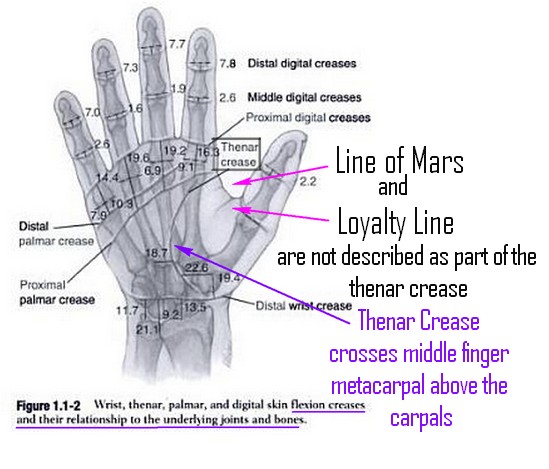
Hand & Wrist - James Doyle
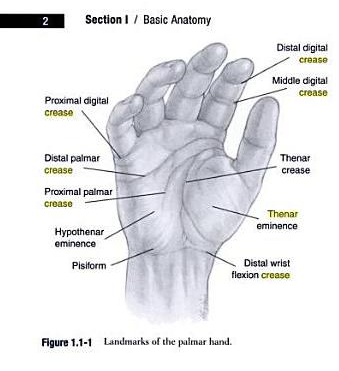
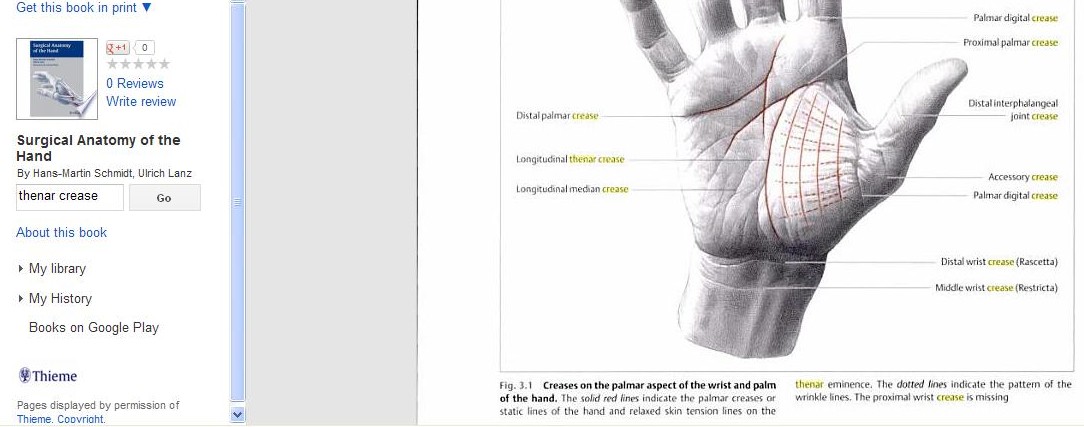
"Surgical Anatomy of the Hand" Schmidt - Lanz (via Google Books)
"They noted that a thenar branch of the median nerve with a transligamentous course correlates in a significantly high number of cases with ulnar terminal branches of the longitudinal thenar crease. In contrast, radial terminal extensions of the thenar crease suggest an extraligamentous course of the nerve."
"Surgical Anatomy of the Hand" Schmidt - Lanz
In palmistry that includes a basis in science, this short inner line should not really count as a short life line if there is another crease defining the boundary of the thenar pad.
Last edited by Patti on Mon Aug 27, 2012 7:04 am; edited 1 time in total

Patti- Posts : 3912
Join date : 2010-07-24
 Re: Any Body Can Give Any Answer For This (length life line)
Re: Any Body Can Give Any Answer For This (length life line)
Let me make two things clear.
1) A cerebral stroke does not mean the person will die soon. I have seen people living 4-5 yrs after such strokes. I think many of you would know that too. Otherwise, people won't go to doctors in such cases
2) The palmist was not aware of the patient's age. Even when he had inquired, he got a wrong estimate. For the palmist, he was giving prediction at least 2.5 yrs ahead.
3) Hence, you are drawing a conclusion (The person was sick and likely to die soon. Hence, the prediction is more of a guess work - paraphrasing the intent your comments, as I have understood) is a wrong one.
The point is - I have seen such longevity predictions & I am ready to believe that such prediction is possible in short term. No amount of theories can substitute an observed event.
Yes, long term predictions are difficult. Because an observed defect may get modified / strengthened by a repair line etc in course of time. Or a perfect feature may get weakened in course of time.
regards
Chakraborty
chakraborty- Posts : 85
Join date : 2012-07-14
Page 7 of 10 •  1, 2, 3, 4, 5, 6, 7, 8, 9, 10
1, 2, 3, 4, 5, 6, 7, 8, 9, 10 
 Similar topics
Similar topics» line split frm head line touching life line going towards mount of moon
» Worried about health line rising from life line in non dominant hand
» Mercury Line forms triangle with forked life line
» Life line broken in both hands (fate line?)
Modern Hand Reading Forum - Discover the language of your hands: palm reading & palmistry forum! :: III - MODERN HAND READING - Various systems for reading hands! :: IIIa - Modern Palmistry: general topics, questions






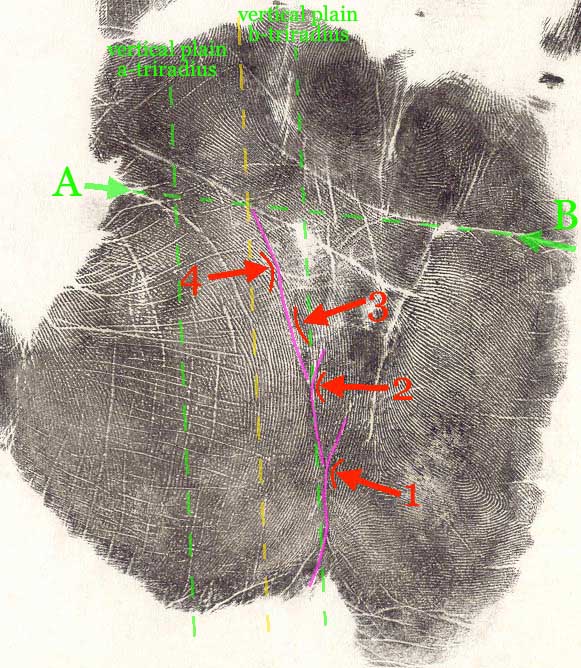

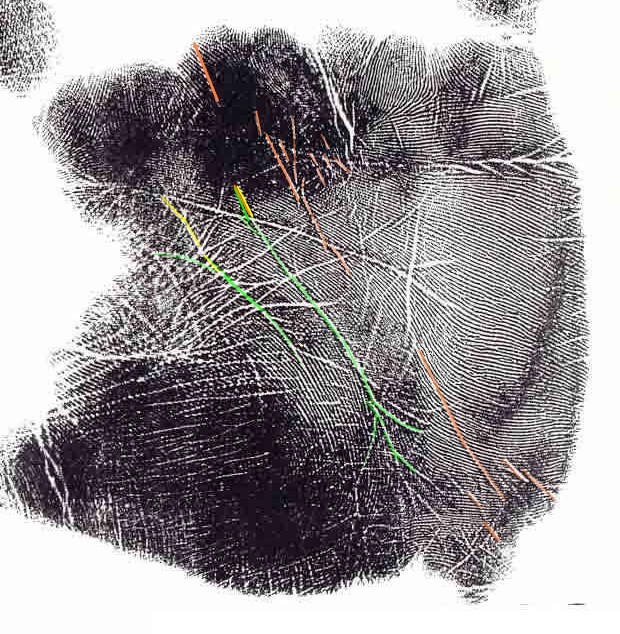
» Teacher square on my Jupiter mount
» Handreading International Conference 2024
» Can anyone read it for me?
» Are there any signs in the hands that you are a twin flame?
» Square on Marriage line
» Cross in mount Jupiter
» clinodactyly: top phalanges bending towards Mercury finger
» Can anybody please read this hand
» Nisha Ghai
» Absolutely non-sense career till now
» Fate Destiny Line -
» VIII - Palmistry books TOP 100 - listed by 'Amazon Sales Rank'!
» Stewart Culin - Palmistry in China and Japan
» Herbert Giles - Palmistry in China